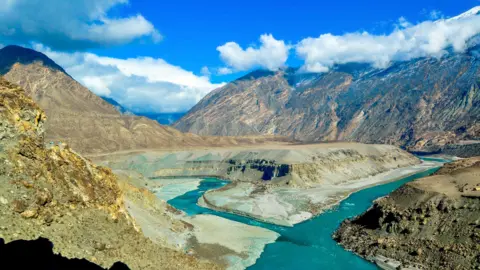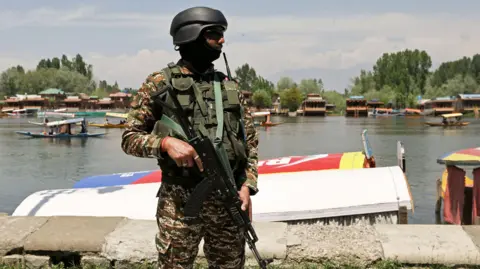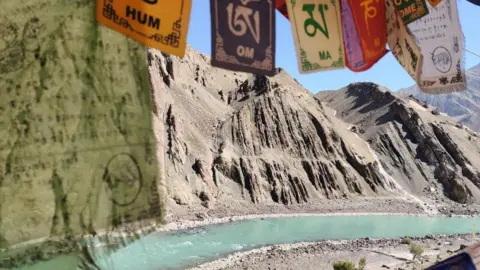Environment correspondent, BBC World Service
 Getty Images
Getty ImagesWill India be able to stop the Indus river and two of its tributaries from flowing into Pakistan?
That’s the question on many minds, after India suspended a major treaty governing water sharing of six rivers in the Indus basin between the two countries, following Tuesday’s horrific attack in Indian-administered Kashmir.
The 1960 Indus Waters Treaty (IWT) survived two wars between the nuclear rivals and was seen as an example of trans-boundary water management.
The suspension is among several steps India has taken against Pakistan, accusing it of backing cross-border terrorism – a charge Islamabad flatly denies. It has also hit back with reciprocal measures against Delhi, and said stopping water flow “will be considered as an Act of War”.
The treaty allocated the three eastern rivers – the Ravi, Beas and Sutlej – of the Indus basin to India, while 80% of the three western ones – the Indus, Jhelum and Chenab – to Pakistan.
Disputes have flared in the past, with Pakistan objecting to some of India’s hydropower and water infrastructure projects, arguing they would reduce river flows and violate the treaty. (More than 80% of Pakistan’s agriculture and around a third of its hydropower depend on the Indus basin’s water.)
 EPA
EPAIndia, meanwhile, has been pushing to review and modify the treaty, citing changing needs – from irrigation and drinking water to hydropower – in light of factors like climate change.
Over the years, Pakistan and India have pursued competing legal avenues under the treaty brokered by the World Bank.
But this is the first time either side has announced a suspension – and notably, it’s the upstream country, India, giving it a geographic advantage.
But what does the suspension really mean? Could India hold back or divert the Indus basin’s waters, depriving Pakistan of its lifeline? And is it even capable of doing so?
Experts say it’s nearly impossible for India to hold back tens of billions of cubic metres of water from the western rivers during high-flow periods. It lacks both the massive storage infrastructure and the extensive canals needed to divert such volumes.
“The infrastructure India has are mostly run-of-the-river hydropower plants that do not need massive storage,” said Himanshu Thakkar, a regional water resources expert with the South Asia Network on Dams, Rivers and People.
Such hydropower plants use the force of running water to spin turbines and generate electricity, without holding back large volumes of water.
Indian experts say inadequate infrastructure has kept India from fully utilising even its 20% share of the Jhelum, Chenab and Indus waters under the treaty – a key reason they argue for building storage structures, which Pakistan opposes citing treaty provisions.
Experts say India can now modify existing infrastructure or build new ones to hold back or divert more water without informing Pakistan.
“Unlike in the past, India will now not be required to share its project documents with Pakistan,” said Mr Thakkar.
 Getty Images
Getty ImagesBut challenges like difficult terrain and protests within India itself over some of its projects have meant that construction of water infrastructure in the Indus basin has not moved fast enough.
After a militant attack in Indian-administered Kashmir in 2016, Indian water resources ministry officials had told the BBC they would speed up construction of several dams and water storage projects in the Indus basin.
Although there is no official information on the status of such projects, sources say progress has been limited.
Some experts say that if India begins controlling the flow with its existing and potential infrastructure, Pakistan could feel the impact during the dry season, when water availability is already at its lowest.
“A more pressing concern is what happens in the dry season – when the flows across the basin are lower, storage matters more, and timing becomes more critical,” Hassan F Khan, assistant professor of Urban Environmental Policy and Environmental Studies at Tufts University, wrote in the Dawn newspaper.
“That is where the absence of treaty constraints could start to be felt more acutely.”
 Getty Images
Getty ImagesThe treaty requires India to share hydrological data with Pakistan – crucial for flood forecasting and planning for irrigation, hydropower and drinking water.
Pradeep Kumar Saxena, India’s former IWT commissioner for over six years, told the Press Trust of India news agency that the country can now stop sharing flood data with Pakistan.
The region sees damaging floods during the monsoon season, which begins in June and lasts until September. But Pakistani authorities have said India was already sharing very limited hydrological data.
“India was sharing only around 40% of the data even before it made the latest announcement,” Shiraz Memon, Pakistan’s former additional commissioner of the Indus Waters Treaty, told BBC Urdu.
Another issue that comes up each time there is water-related tension in the region is if the upstream country can “weaponise” water against the downstream country.
This is often called a “water bomb”, where the upstream country can temporarily hold back water and then release it suddenly, without warning, causing massive damage downstream.
Could India do that?
Experts say India would first risk flooding its own territory as its dams are far from the Pakistan border. However, it could now flush silt from its reservoirs without prior warning – potentially causing damage downstream in Pakistan.
Himalayan rivers like the Indus carry high silt levels, which quickly accumulate in dams and barrages. Sudden flushing of this silt can cause significant downstream damage.
There’s a bigger picture: India is downstream of China in the Brahmaputra basin, and the Indus originates in Tibet.
In 2016, after India warned that “blood and water cannot flow together” following a militant attack in Indian-administered Kashmir which India blamed on Pakistan, China blocked a tributary of the Yarlung Tsangpo – that becomes the Brahmaputra in northeast India.
China, that has Pakistan as its ally, said they had done it as it was needed for a hydropower project they were building near the border. But the timing of the move was seen as Beijing coming in to help Islamabad.
After building several hydropower plants in Tibet, China has green-lit what will be the world’s largest dam on the lower reaches of Yarlung Tsangpo.
Beijing claims minimal environmental impact, but India fears it could give China significant control over the river’s flow.




